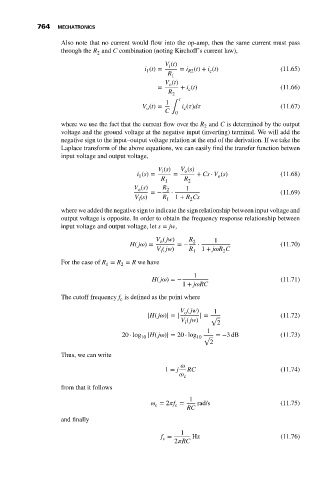Page 778 - Mechatronics with Experiments
P. 778
764 MECHATRONICS
Also note that no current would flow into the op-amp, then the same current must pass
through the R and C combination (noting Kirchoff’s current law),
2
V (t)
i
i (t) = = i (t) + i (t) (11.65)
1 R2 c
R
1
V (t)
o
= + i (t) (11.66)
c
R 2
t
1
V (t) = i ( )d (11.67)
o C ∫ c
0
where we use the fact that the current flow over the R and C is determined by the output
2
voltage and the ground voltage at the negative input (inverting) terminal. We will add the
negative sign to the input–output voltage relation at the end of the derivation. If we take the
Laplace transform of the above equations, we can easily find the transfer function betwen
input voltage and output voltage,
V (s) V (s)
o
i
i (s) = = + Cs ⋅ V (s) (11.68)
1
o
R 1 R 2
V (s) R
o 2 1
=− ⋅ (11.69)
V (s) R 1 1 + R Cs
i
2
where we added the negative sign to indicate the sign relationship between input voltage and
output voltage is opposite. In order to obtain the frequency response relationship between
input voltage and output voltage, let s = jw,
V ( jw) R 2 1
o
H( j ) = =− ⋅ (11.70)
V ( jw) R 1 + j R C
i 1 2
For the case of R = R = R we have
1 2
1
H( j ) =− (11.71)
1 + j RC
The cutoff frequency f is defined as the point where
c
V ( jw) 1
o
|H( j )| = | | = √ (11.72)
V ( jw) 2
i
1
20 ⋅ log |H( j )| = 20 ⋅ log 10 √ =−3 dB (11.73)
10
2
Thus, we can write
1 = j RC (11.74)
c
from that it follows
1
= 2 f = rad/s (11.75)
c
c
RC
and finally
1
f = Hz (11.76)
c
2 RC

